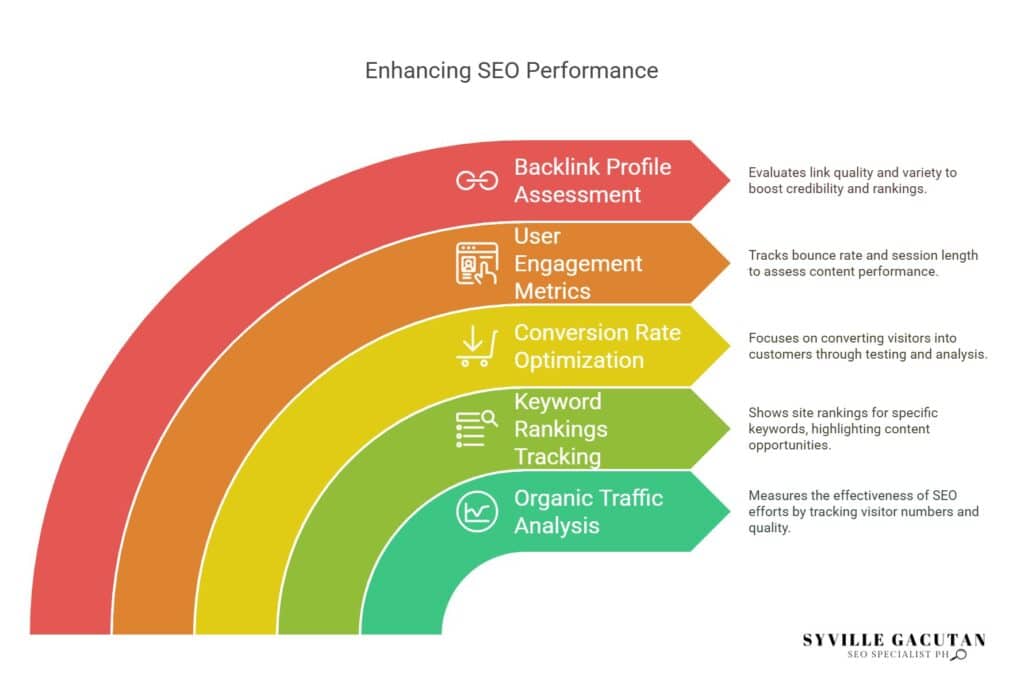
Measuring SEO Success: Key Metrics and Analytics Tools
Measuring SEO success involves the systematic analysis of key metrics and the use of sophisticated analytics tools. Key metrics like organic traffic, how your site ranks for keywords, and conversion rates provide insights into the effectiveness of SEO strategies. Evaluating user engagement metrics, such as the percentage of visitors who leave your site quickly (bounce rate) and the average time visitors spend on your site, helps ensure your content meets user expectations. Furthermore, factors like how fast your website loads and how well it works on mobile devices can also impact your search rankings and the overall experience for visitors. Backlink profiles also play a significant role in boosting credibility and authority. Explore deeper insights to effectively optimize your digital presence and gain a competitive edge.
Key Takeaways
- Organic traffic analysis: Measures how well your SEO efforts are working by tracking the number and quality of visitors from unpaid searches.
- Keyword rankings tracking: Shows how your site ranks for specific keywords, helping you find opportunities to improve or create new content.
- Conversion rate optimization: Focuses on turning visitors into customers by testing different website elements and analyzing user behavior.
- User engagement metrics: Tracks bounce rate and session length to see how well your content performs and how satisfied users are.
- Backlink profile assessment: Looks at the quality and variety of links to your site, boosting credibility and helping improve search rankings.

Organic Traffic Analysis

Organic traffic analysis serves as a foundational metric in evaluating the effectiveness of an SEO strategy. By examining the volume and quality of visitors arriving at a website through unpaid search results, businesses can get a clearer understanding of how their website is performing online.
A critical component of this analysis is content quality, which directly influences user engagement and search engine rankings. Producing high-quality content that satisfies user needs and matches search intent is more likely to draw in organic traffic and keep your audience engaged.
Understanding the people who visit a website is very important for analyzing the traffic that comes from search engines and other sources. By identifying details about the visitors, such as their age, where they live and what they are interested in, businesses can create content that better matches the needs of the people they want to reach.
This alignment not only improves the user experience but also increases the likelihood of conversion, making it a vital consideration in SEO strategy development.
Competitor analysis further strengthens organic traffic evaluation. By benchmarking against competitors, businesses can find gaps and opportunities to improve their SEO approach.
This analysis can reveal which keywords competitors are ranking for, the quality of their content, and how they address search intent, providing valuable insights for refining one’s own strategy.
Seasonal trends can make a big difference in organic traffic fluctuations. Understanding these patterns allows businesses to anticipate changes in search behavior and adjust their content and marketing strategies accordingly.
For instance, a surge in certain search queries during specific times of the year can inform content planning and promotional efforts, ensuring that businesses remain relevant and competitive throughout the year.
Keyword Rankings Tracking
Building upon the insights gained from organic traffic analysis, tracking keyword rankings offers a more granular view of SEO performance. This metric provides a direct indicator of how well your site is positioned in search results for specific queries. Understanding keyword difficulty is essential; it reflects how challenging it is to rank for a particular term. By analyzing search intent, businesses can align their content to meet user needs more effectively, thereby improving rankings.
Keyword rankings tracking also involves the strategic use of long tail keywords. These are typically less competitive but highly specific, allowing for better targeting of niche audiences. Integrating these into your content optimization strategy can significantly boost visibility and traffic.
Competitor analysis is another crucial component. By observing how competitors rank for similar terms, businesses can identify gaps and opportunities in their own SEO strategies. This can lead to more informed decisions on content creation and keyword targeting.
The table below illustrates the relationship between these elements:
| Element | Description |
| Keyword Difficulty | Reflects how competitive it is to rank for a specific keyword. |
| Search Intent | Understanding the purpose behind a user’s search query. |
| Long Tail Keywords | Specific, less common keywords that target niche markets. |
| Competitor Analysis | Studying competitors to identify opportunities and gaps in keyword ranking. |
Conversion Rate Optimization

A crucial aspect of digital marketing success, conversion rate optimization (CRO) focuses on enhancing the effectiveness of a website in turning visitors into customers. By meticulously analyzing user behavior and preferences, CRO aims to improve the overall user experience and increase the likelihood of conversions.
One of the most powerful tools in this process is A/B testing strategies, which allow marketers to compare different versions of a webpage to determine which one performs better in terms of conversion rates.
Funnel analysis plays a critical role in CRO by examining each step a potential customer takes from first interaction to final purchase. This analysis helps identify any friction points within the conversion funnel where users may drop off, thus highlighting areas for improvement.
By understanding the journey a user takes, businesses can implement changes to streamline the process and guide users more effectively towards conversion.
Heatmap tracking is another vital component of CRO, offering visual insights into how users interact with a webpage. By observing where users click, scroll, or hover, marketers can identify which elements capture attention and which may be overlooked, enabling data-driven adjustments to layout and design.
Additionally, user feedback is invaluable in understanding the motivations and frustrations of website visitors. Gathering insights directly from users can reveal pain points that might not be evident through analytics alone, allowing for targeted improvements.
Bounce Rate Insights
Understanding user engagement on a website involves not only looking at conversion rates but also examining bounce rate insights. The bounce rate represents the percentage of visitors who navigate away from the site after viewing only one page. Analyzing bounce rate trends can provide valuable information about user behavior and how effectively a site meets visitor expectations.
A high bounce rate may indicate that users do not find the content relevant or engaging, prompting them to leave before exploring further. This can be influenced by several factors, including mismatched keyword targeting, poor content quality, or an unappealing user interface. To address such issues, it is essential to evaluate the alignment between user intent and the content provided. Enhancing content relevance can significantly improve user retention and engagement.
Exit pages are another critical factor in understanding bounce rate. Identifying pages with the highest exit rates helps pinpoint where users abandon the site, offering insights into potential content gaps or navigational challenges. By optimizing these pages, businesses can enhance user experience and encourage deeper site exploration, thereby reducing the bounce rate.
Moreover, session duration, the average time users spend on a site, is closely related to bounce rate. Short session durations often correlate with high bounce rates, suggesting that users are not sufficiently engaged with the content. By analyzing session duration alongside bounce rate, businesses can identify opportunities to enhance content quality and interactivity, encouraging users to spend more time on the site.
Page Load Time Impact

In the realm of SEO, page load time plays a pivotal role in shaping user experience and influencing website success. A fast-loading website not only enhances user satisfaction but also improves site performance, which can significantly impact search engine rankings. Page speed is a critical component of technical SEO, as search engines prioritize websites that deliver swift and seamless interactions. Users demand immediate access to information, and delays can lead to increased bounce rates and diminished engagement.
From a technical SEO perspective, optimizing page load time involves several strategies. Compressing images, leveraging browser caching, reducing server response times, and minimizing JavaScript and CSS can all contribute to faster page speeds. These improvements align with Google’s Core Web Vitals, a set of metrics designed to evaluate critical aspects of user experience, such as loading performance, interactivity, and visual stability.
Core Web Vitals emphasize the importance of metrics like Largest Contentful Paint (LCP), First Input Delay (FID), and Cumulative Layout Shift (CLS), which collectively assess the quality of a user’s browsing experience.
Furthermore, site performance is not solely about satisfying search engine algorithms; it is about meeting user expectations. A sluggish website can deter users, affecting conversion rates and brand perception. Thus, monitoring and enhancing page speed is essential for businesses seeking to maintain a competitive edge in digital landscapes.
Employing tools like Google PageSpeed Insights and GTmetrix can provide valuable insights into page load times, guiding improvements and ensuring that a website’s technical foundation supports optimal user experience and SEO success.
Backlink Profile Assessment

Evaluating a website’s backlink profile is a fundamental aspect of measuring SEO success, as it directly influences search engine rankings and domain authority. A strong backlink profile not only enhances a site’s credibility but also signals to search engines that the website is a trustworthy source of information. To achieve this, it’s essential to assess various elements of backlinks.
Primarily, link quality is crucial; high-quality links from reputable sites are far more beneficial than numerous low-quality ones. Ensuring that backlinks come from authoritative domains increases a site’s domain authority and enhances its potential to rank higher.
In addition to link quality, examining anchor text is vital. Anchor text, the clickable part of a hyperlink, should be relevant to the linked content and varied to avoid over-optimization penalties.
A comprehensive backlink profile should exhibit backlink diversity. This means having a range of links from different types of sources such as forums, blogs, news sites, and directories, which indicates natural link-building practices to search engines.
Conducting a competitor analysis can offer insights into potential linking opportunities. By understanding where competitors are gaining their links, you can identify gaps and strategies to improve your link-building efforts.
To summarize, an effective backlink profile assessment involves:
- Evaluating link quality to ensure links are from reputable sources.
- Analyzing anchor text for relevance and diversity.
- Ensuring backlink diversity to represent a natural link profile.
- Performing competitor analysis to benchmark and strategize link-building efforts.
Mobile Usability Evaluation

With the increasing prevalence of smartphones, ensuring mobile usability has become a critical component of SEO success. As users increasingly rely on mobile devices for browsing, a mobile friendly design is essential for meeting their expectations and enhancing user experience.
By adopting responsive layout testing, businesses can ensure that their websites adapt seamlessly to various screen sizes and orientations, providing a consistent experience across all devices. This adaptability not only improves user satisfaction but also aligns with search engine algorithms that favor mobile-responsive sites.
User experience optimization involves more than just aesthetic appeal; it encompasses the speed, functionality, and accessibility of a website on mobile platforms. A well-optimized site should load quickly, as mobile users typically expect fast access to information.
Accessibility considerations are also paramount, ensuring that all users, including those with disabilities, can navigate the site effectively. This might include implementing features like text-to-speech, adjustable font sizes, and clear navigation paths.
Moreover, understanding and aligning with search intent is vital. Mobile users often have different needs compared to desktop users, such as looking for quick answers or local business information. Tailoring content to meet these specific intents can enhance engagement and conversion rates.
Tools like Google’s Mobile-Friendly Test and PageSpeed Insights can be instrumental in evaluating a site’s mobile usability.
Ultimately, integrating these aspects into a mobile usability evaluation cultivates a holistic approach, ensuring that a website is not only accessible and functional but also aligned with the evolving expectations of mobile users, thereby boosting SEO performance and visibility in search engine results.
User Engagement Metrics

Understanding user engagement metrics is crucial for assessing the effectiveness of SEO strategies and the overall health of a website. These metrics offer insights into how users interact with a website, revealing the success of content relevance and the efficacy of engagement strategies.
Evaluating user behavior helps in identifying areas that require improvement, ensuring that the website meets the needs and expectations of its audience.
Key user engagement metrics include:
- Bounce Rate: This metric highlights the percentage of visitors who leave a website after viewing only one page, indicating potential issues with content relevance or user experience.
- Average Session Duration: Measuring the time users spend on a website provides insights into the effectiveness of engagement strategies and whether the content is compelling enough to hold attention.
- Pages Per Session: This metric indicates how many pages a user visits during a single session, reflecting the depth of user engagement and interest in the content offered.
- Social Signals: Engagement on social media platforms, such as likes, shares, and comments, can enhance SEO by driving traffic and validating content relevance to a broader audience.
Considering audience demographics is essential when analyzing user engagement metrics. Different demographics may exhibit distinct user behaviors, impacting how content should be tailored to optimize engagement.
Final Thoughts
Measuring SEO success requires a comprehensive approach that examines multiple key metrics and leverages analytics tools. By focusing on organic traffic, keyword rankings, conversion rates, and user engagement metrics like bounce rate and session duration, businesses can identify strengths and areas for improvement. Optimizing page load times, mobile usability, and maintaining a robust backlink profile are also critical components of a successful SEO strategy.
Ready to take your SEO performance to the next level? Connect with Syville Gacutan, an experienced SEO Specialist in the Philippines. Syville can help you measure, analyze, and optimize your SEO strategies for maximum results. Don’t leave your SEO success to chance—get expert support and achieve your digital goals today!